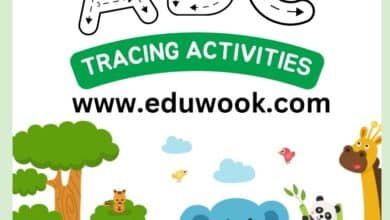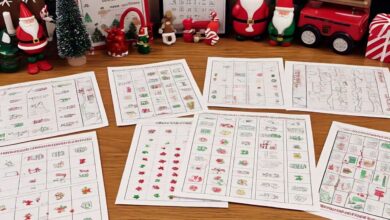5 Incredible Ways Play-Based Learning Boosts Growth
Play-based learning is key for kids to grow and learn. It helps them develop important skills through play. A Harvard study shows it can make kids healthier and happier1.
It makes kids smarter and better at managing stress1. Play-based learning lets kids explore and learn by doing. This is a natural way for them to learn about the world.
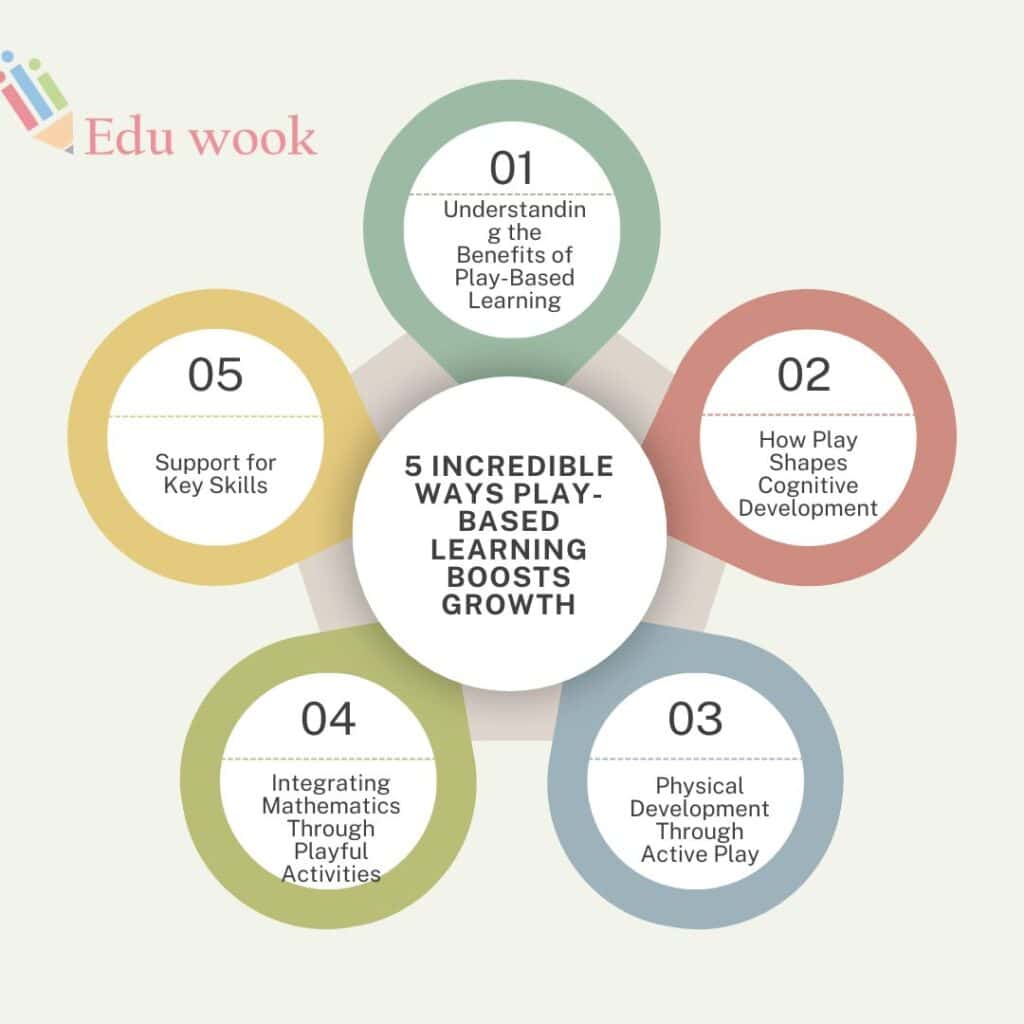
Play-based learning lets kids learn through hands-on experiences. A study by Parker and Thomsen (2019) found it’s better than old teaching methods2. The American Psychological Association says it’s good for kids’ health and happiness2.
It makes learning fun and exciting for kids. This is why it’s so important in early education.
Key Takeaways
- Play-based learning is an essential component of every child’s growth and development.
- It allows children to develop the skills they need to thrive through learning through play and play in education.
- Play-based learning provides opportunities for children to learn about the world around them through play.
- It instills enthusiasm and joy for learning in children, making it an essential component of early childhood education.
- Play-based learning has numerous benefits, including improved cognitive flexibility, stronger memory recall, and greater self-regulation1.
Understanding the Benefits of Play-Based Learning
Play-based learning lets kids play and learn in fun ways. It helps them grow smarter, do better in school, and make friends easier3. It makes kids curious and creative, letting them learn at their own speed. Activities like pretending and telling stories help kids talk better, feel for others, and be more confident4.
A play-based curriculum includes many fun activities. Kids can build with blocks, sort things, and solve puzzles. These help them think better and use their hands3. It also helps kids work together, share, and solve problems, teaching them important social skills4.
Play-based learning has many benefits. It makes kids smarter, more creative, and better at making friends5. Teachers can make learning fun and effective by using play-based activities. Play is key to helping kids grow and be happy.
How Play Shapes Cognitive Development
Play helps kids learn and grow. It lets them explore and solve problems. They also get better at thinking and being creative6.
Play makes kids understand the world better. This is key for their brains to grow. Studies show kids who play do better in school than those who just study6.
Some big benefits of play are:
- Play makes kids think better, with a 30% boost in critical thinking7.
- It helps kids solve problems, with 75% of teachers saying it’s a big help7.
- Play also makes kids better at getting along and talking, with a 50% boost in social skills7.
Play teaches kids important skills like solving problems and thinking critically. It also helps with language and understanding feelings6
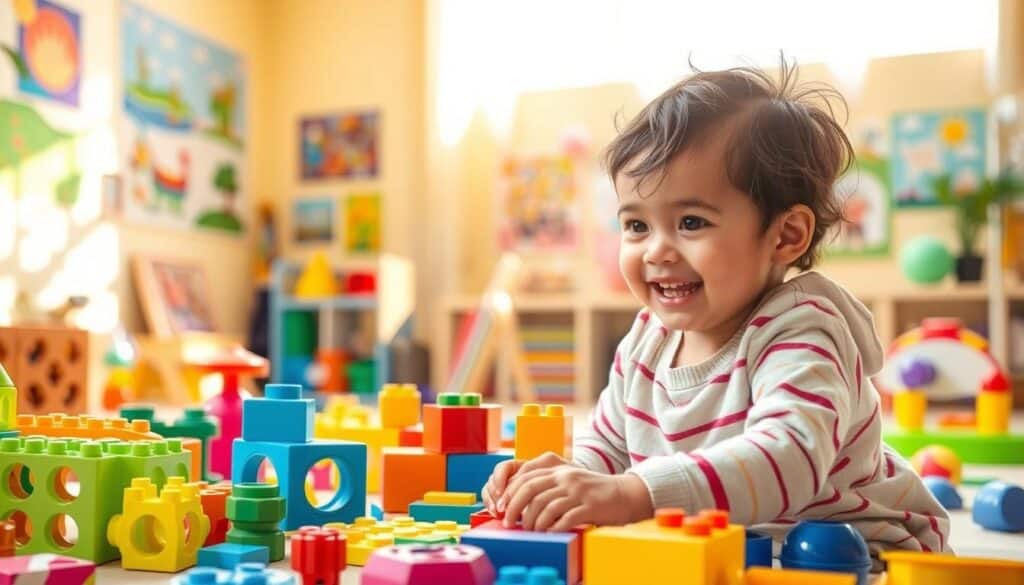
The Role of Play in Social-Emotional Growth
Play helps kids learn to get along with others. They learn important skills like how to solve problems and understand feelings8. It’s key for growing up well.
Play lets kids know themselves and others better. This is vital for growing up right9. It helps them learn to talk well, work together, and solve problems9.
Some good things about play include:
- Improved communication and cooperation among children
- Enhanced emotional intelligence and empathy
- Developed conflict resolution strategies
Play can be fun activities like acting out stories or making art8. Teachers can use these to help kids grow up well9.
Teachers who focus on play help kids do well in school and life8. Play is very important for kids’ happiness and success9.
Physical Development Through Active Play
Play is key for kids’ growth, and moving around is a big part of it. Kids can get better at balancing, moving, and using their hands through play. This helps them stay healthy and feel good10.
Studies show kids who play feel less stressed. They also get better at controlling their feelings and excitement10.
Kindergarten worksheets can make playtime more fun. Kids can use blocks and puzzles to learn numbers and shapes. They also get to practice moving and using their hands11.
Playing outside is great too. It helps kids get stronger and more fit11.
Being active is good for kids’ hearts and bones. It also helps prevent obesity and diabetes11. The National Childhood Network says kids should move for 60 minutes a day. They should also do exercises to make their bones and muscles strong11.
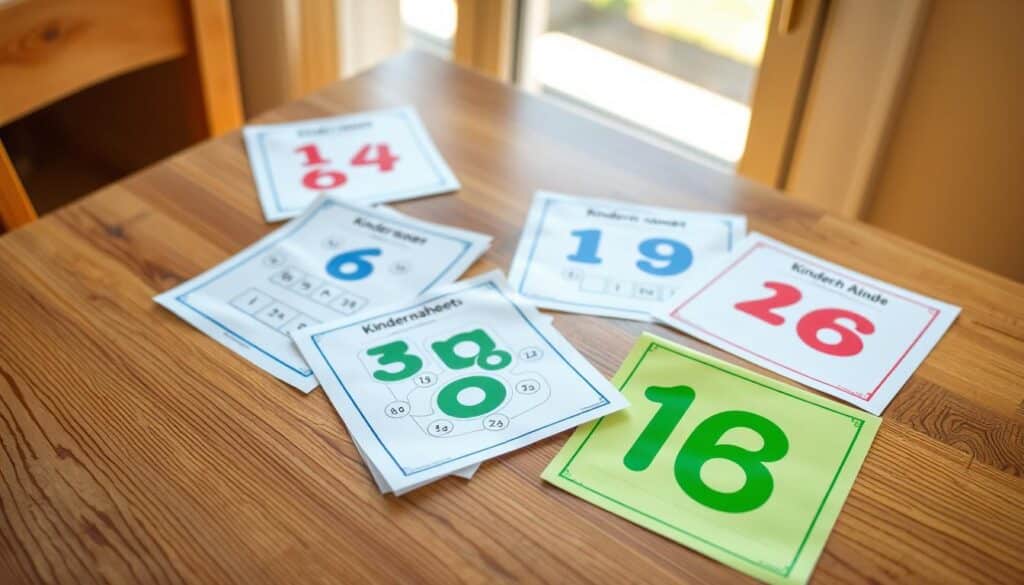
Play can be adjusted for each child. It can include music, dance, and art. Adding kindergarten worksheets to play helps kids learn and grow. It sets them up for success in school and a love for learning.
Creating an Effective Play-Based Learning Environment
Designing a play-based learning environment is key. It boosts student engagement and learning12. A good setup meets different learning needs. It also includes outdoor areas for kids to explore and get active12.
Some important things for a play-based learning space are:
- Materials and resources that help kids learn through play
- A room layout that lets kids explore on their own
- Safe spaces for kids to play and learn without worry
A safe and organized play area makes kids feel safe and ready to learn. Studies show play helps kids control impulses and solve problems13. It also helps kids understand and value different cultures12.
Setting clear rules and values is important. It makes the classroom a positive place for everyone. Teachers can help each student grow by observing and supporting them in play12. This way, every student gets the chance to learn and grow in their own way.
Integrating Mathematics Through Playful Activities
Play in education is key in a play-based curriculum. It helps kids learn math in a fun way. Early math skills are linked to later success14.
Playful activities teach kids important math skills. They learn to compare numbers, estimate on number lines, count, and recognize numbers.
A study showed playing a number board game helped low-income kids a lot. They got better at comparing numbers and more14. They even kept learning 9 weeks later14.
Play-based learning is great for math. It makes learning fun and keeps kids interested. It also helps them solve problems and think deeply.
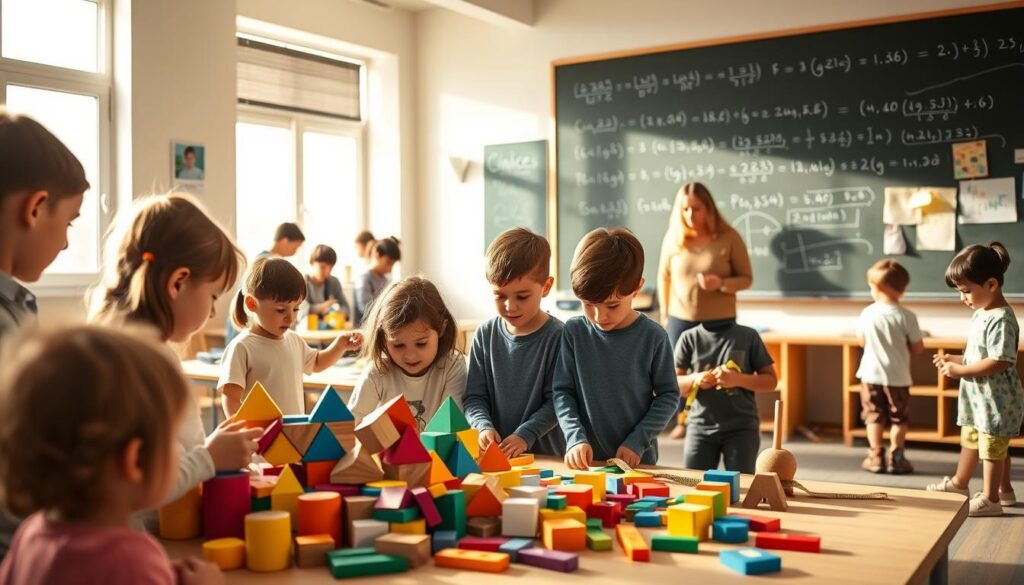
Using things like snap cubes and pattern blocks helps teach math15. Setting aside a day each week for games helps young students learn more15. Making math fun helps kids love learning and understand math well.
Language Development in Play-Based Settings
Play-based learning helps kids grow their language skills. They learn new words and stories through fun activities16. It’s great for their language and reading skills16.
Play is better than just sitting in class for young kids17. It makes learning fun and engaging17.
Playing with friends helps kids learn more words16. They also get better at telling stories16. This is because they talk and work together16.
Playing nicely with others is key. It helps kids learn new words and tell stories better16. They also learn to solve problems and make friends17.
Guided play is good for learning many things. This includes math, reading, and even how to find your way around18. It’s also important for kids to learn on their own18.
Free play is great for learning to read and write18. It helps kids learn in a fun way18.
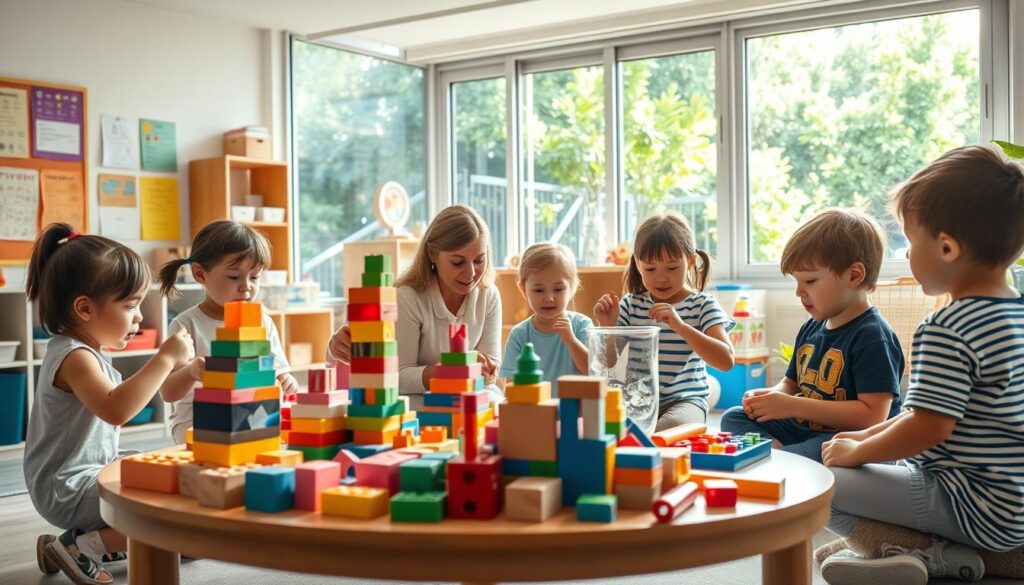
Play helps kids understand language better. They learn new words and how to use them16. It’s a big part of learning to talk and grow emotionally16.
Play is very important for young kids. It helps them learn and grow in a fun way17.
The Role of Adults in Guided Play
Adults are very important in guided play. They help children learn and grow. By using fun teaching methods, adults make learning fun and safe for kids19. Studies show that guided play helps kids learn more than just playing freely19.
Guided play works best for learning new things in early school years19. A big study looked at 39 studies from 1977 to 2020. It found that guided play helps kids learn math and shapes better20. Kids who go to play-based preschools are less likely to get into trouble later21.
Some great things about guided play are:
- It helps kids learn more
- It makes kids better at switching between tasks
- It helps with important skills like reading, math, and getting along with others
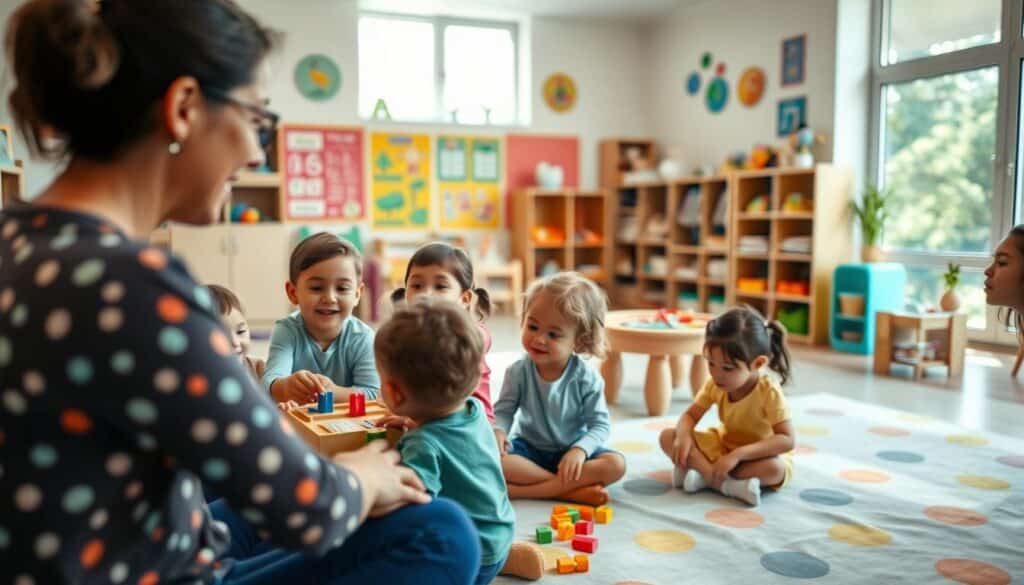
Adults can help kids learn and grow by using play-based teaching. This supports play-based education and helps kids develop well192021.
| Guided Play Benefits | Description |
|---|---|
| Improved Learning Outcomes | Guided play leads to higher learning outcomes compared to free play |
| Enhanced Cognitive Ability | Guided play enhances children’s cognitive ability to switch between tasks |
| Support for Key Skills | Guided play supports key skills such as literacy, numeracy, social skills, and executive functions |
Assessment Strategies in Play-Based Learning
Assessment is key in play-based learning. It shows how kids learn and grow. Play helps kids grow in many ways, like thinking, feeling, and moving.
Teachers find it hard to check on kids during play. They have to meet many rules22. Most often, they watch kids play and take them out to check their work22.
Good ways to check on kids include:
- Watching them play to see what they learn.
- Writing down what they do to see their progress.
- Using tools to see how they grow over time.
A study showed 50% of teachers like checking on kids through play23. The New Zealand Ministry of Education says checking on kids helps them learn better and helps teachers teach better23. These methods help us see how kids grow, which is great for play-based learning.
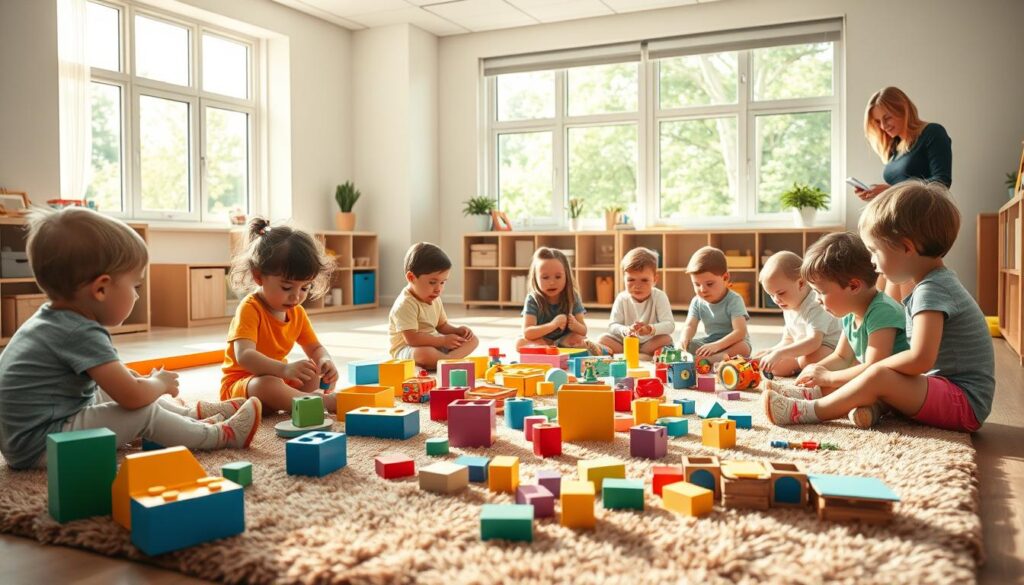
Overcoming Common Challenges in Implementation
Starting a play-based curriculum can be tough. But, with good planning and support, we can beat these hurdles. Play helps kids grow smart, feel good about themselves, and stay healthy. Before they turn 5, play is their main way of learning24.
As kids get older, they face a big change. They move from playing to learning in a more serious way. This change can make parents and teachers unsure about play-based learning24.
To tackle these issues, we need a place where kids feel safe and excited to learn. We can use different ways to make learning fun, like the Reggio Emilia method. It lets kids learn by asking open-ended questions24. Forest Schools also help by letting kids play outside and learn to be brave24.
Play-based learning has many good points. It makes kids smarter, helps them get along with others, and keeps them active. By using these methods, teachers can make learning fun and helpful for kids. Play helps kids deal with hard times and feel okay with not knowing everything25.
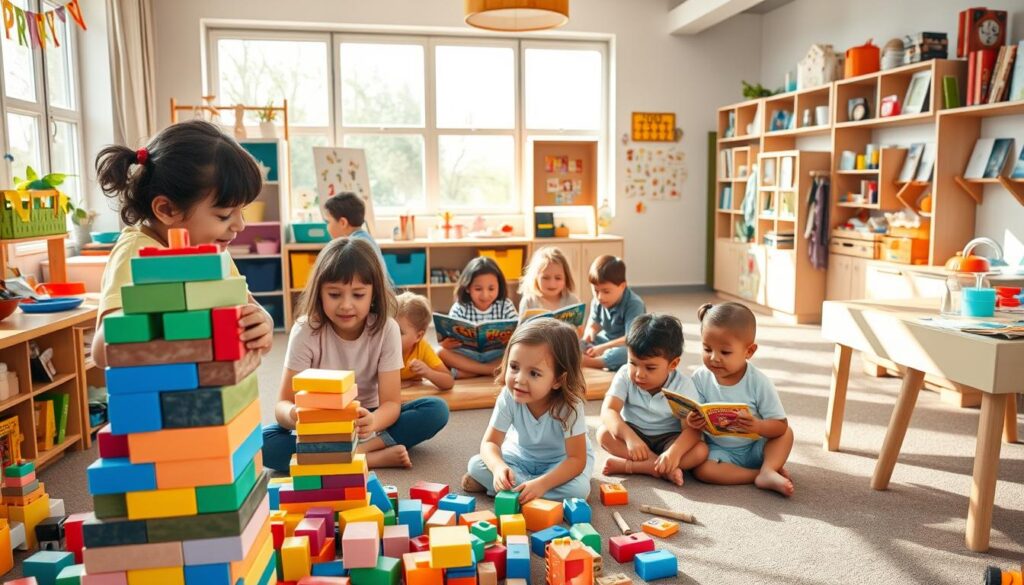
Starting a play-based curriculum needs careful thought and help. But, the benefits of play make it worth it. Teachers can help kids grow and reach their goals by making learning fun and supportive. This shows how important play is in learning24.
Technology Integration in Playful Learning
Technology can help kids learn in fun ways. It gives them digital tools to learn and grow. This helps them understand the world better, which is key for their brains to develop26.
Using digital tools like apps and games makes learning fun. It keeps kids active and interested27.
Some cool digital tools for learning include:
- PBS Kids, which makes educational media for young kids27
- The Preschool Data Toolbox app, where kids can make their own stories27
- SolveMe Puzzles, which teach math in a fun way without numbers27
It’s important to mix tech with old-school play. This way, kids get a good mix of skills28. Play helps them understand the world better. Digital tools make this learning fun and engaging.
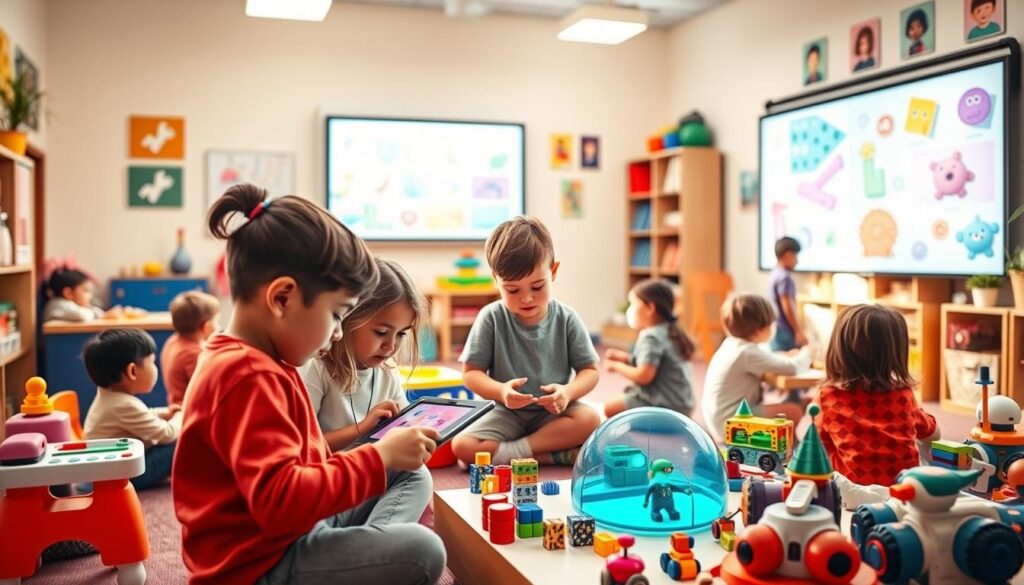
Technology is great for learning through play. It offers many digital tools to help kids learn and grow. By mixing play with tech, kids learn a lot and get a wide range of skills26.
Cultural Considerations in Play-Based Education
Cultural considerations are key in play-based education. They help make a learning space that’s welcoming and inclusive. Adults can use play to make learning fun and engaging for kids29. This is important for kids’ growth and learning29.
What kids learn at home shapes how they play. Kids like playing in ways they’ve seen before30. Adding parts of their home culture to school helps them learn better30.
Teachers can make a learning space that values all cultures. They can talk to families and learn about their traditions30. This helps teachers understand and support families and kids better30.
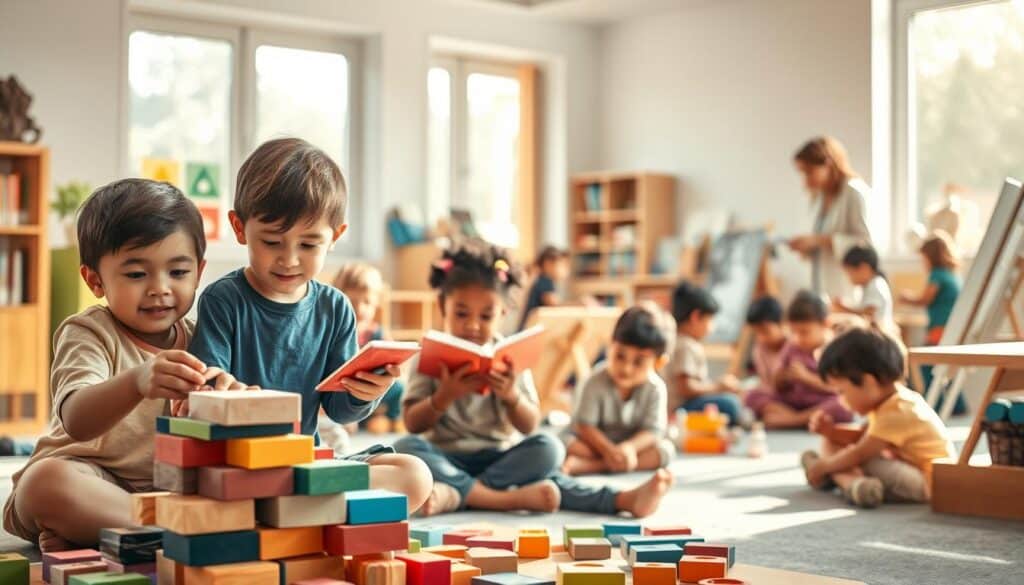
In the end, thinking about culture is very important in play-based education29. Teachers should focus on making learning fun and inclusive for all kids29. This way, they help kids grow and learn in a supportive environment.
Conclusion: Embracing the Power of Play in Learning
Play-based learning is very good for kids. It helps them grow and learn in many ways31. Kids get smarter and better at working with others and moving their bodies31.
Studies show kids who play a lot solve problems better31. They learn new words faster31 and move better31. Plus, 90% of parents say it makes kids love school32.
Teachers and caregivers should make play a big part of learning31. This lets kids explore and be themselves. It helps them grow in all ways32.
By using play in school, we make learning fun and exciting32. Kids learn more and feel happy and confident32.
FAQ
What is play-based learning?
Play-based learning lets students learn by doing and exploring. It’s like learning through play. This is seen as the natural way to learn.
What are the benefits of play-based learning?
It helps kids grow smarter and do better in school. They also learn to solve problems and think creatively. It’s great for their social skills too.
How does play-based learning promote social-emotional growth?
It helps kids learn to work with others and share. They also learn to understand themselves and others better. This is key for growing up well.
What role does physical activity play in play-based learning?
Being active helps kids get better at moving and using their hands. It’s good for their health and helps them love being active.
How can an effective play-based learning environment be created?
You need the right stuff, a good layout, and safety. A safe and organized place makes kids feel ready to learn.
How can play-based learning be used to integrate mathematics into the curriculum?
Fun activities can help kids understand math better. This includes numbers and shapes. It’s good for their brains.
How can play-based learning support language development?
It helps kids learn to talk and tell stories through play. This deepens their understanding of language. It’s key for talking and growing up.
What is the role of adults in guided play?
Adults help kids learn by guiding them. They make learning fun and supportive. This is important for kids to grow.
How can play-based learning be assessed?
You need to watch and track kids’ progress. This helps adults see how much they’ve learned. It shows how they’re growing.
How can the challenges of implementing play-based learning be overcome?
It’s tough, but with planning and support, it works. Adults can make learning fun and help kids succeed.
How can technology be integrated into play-based learning?
Tech can add to learning, but balance is key. It helps kids learn more about the world. This is good for their brains.
What cultural considerations are important in play-based education?
It’s important to make learning welcoming for all. Play-based learning can be inclusive. This helps kids learn and grow in a safe space.
Source Links
- Play-based Learning: Benefits and Examples – https://journey.edu.au/early-learning-advice/08-2021/blog-play-based-learning-benefits-and-examples/
- Benefits of Play Based Learning in Early Education — My Teaching Cupboard – https://www.myteachingcupboard.com/blog/benefits-of-play-based-learning
- 7 Benefits of Play-Based Learning – The Pillars Christian Learning Centers – https://thepillarsclc.com/2022/03/08/7-benefits-of-play-based-learning/
- The Benefits of Play Based Learning – https://www.nordangliaeducation.com/sisd-dubai/news/2023/10/23/the-benefits-of-play-based-learning
- Play-Based Learning: Why It Should Be Part of the Classroom – https://www.edmentum.com/articles/play-based-learning-in-the-classroom/
- How Play Shapes Learning and Development – https://www.wonderschool.com/blog/family-resources/learning-through-play
- The Power of Play: How Play-Based Learning Shapes Development – post – https://www.childcareed.com/a/the-power-of-play-how-play-based-learning-shapes-development.html
- The Benefits of Play-Based Learning for Emotional Wellness – Educate. Radiate. Elevate. – https://educateradiateelevate.org/the-benefits-of-play-based-learning-for-emotional-wellness/
- The Benefits of Play Based Learning in Child Development – https://poppyseedplay.com/blogs/calm/benefits-of-play-based-learning?srsltid=AfmBOophk51Cwk-Wg-CxOkL9EAbj8iSunAFeVAQDORLLyAF0tGSY2HML
- 4 Ways Play-Based Learning Supports Student Growth – https://www.unrulysplats.com/blog/four-ways-play-based-learning-supports-student-growth
- Promoting Physical Play in Early Childhood: Tips & Benefits – https://playworld.com/blog/how-to-promote-physical-play-in-early-years/
- Creating an Effective Play Based Learning Environment — My Teaching Cupboard – https://www.myteachingcupboard.com/blog/play-based-learning-environment
- Creating a Play-Based Learning Environment to Make Learning Accessible for All – https://medium.com/whats-the-plus/creating-a-play-based-learning-environment-to-make-learning-accessible-for-all-30984d23ebf
- Playing to Learn Mathematics | Encyclopedia on Early Childhood Development – https://www.child-encyclopedia.com/play-based-learning/according-experts/playing-learn-mathematics
- The Playful Approach to Math – https://www.edutopia.org/article/playful-approach-math/
- Preschoolers’ play at home and school as a natural contributor to early literacy and language development | Encyclopedia on Early Childhood Development – https://www.child-encyclopedia.com/language-development-and-literacy/according-experts/preschoolers-play-home-and-school-natural
- Prioritizing Play: The Importance of Play-based Learning in Early Education – https://ies.ed.gov/learn/blog/prioritizing-play-importance-play-based-learning-early-education
- The Power of Playful Learning in the Early Childhood Setting – https://www.naeyc.org/resources/pubs/yc/summer2022/power-playful-learning
- PDF – https://www.child-encyclopedia.com/pdf/expert/play-based-learning/according-experts/how-guided-play-promotes-early-childhood-learning
- Learning through ‘guided’ play can be as effective as adult-led instruction – https://www.cam.ac.uk/research/news/learning-through-guided-play-can-be-as-effective-as-adult-led-instruction
- PDF – https://www.cmu.edu/dietrich/psychology/pdf/klahr/PDFs/Guided Play 2016.pdf
- Assessment in Play-Based Learning | Encyclopedia on Early Childhood Development – https://www.child-encyclopedia.com/play-based-learning/according-experts/assessment-play-based-learning
- PDF – https://core-prod-assets.s3.ap-southeast-2.amazonaws.com/public/Uploads/files/Play-based-Learning-and-assessment-Considerations-on-how-to-marry-the-two-in-a-working-relationship.pdf
- 13 Play Based Learning Benefits and Challenges – https://helpfulprofessor.com/play-based-learning/
- Embracing Learning Through Play – https://www.gse.harvard.edu/ideas/usable-knowledge/23/05/embracing-learning-through-play
- Guiding Students to Creative Uses of Technology – https://www.edutopia.org/article/using-tech-playful-learning-schools/
- Digital Resources for Play-Based Learning in Preschool – https://www.edutopia.org/article/digital-resources-play-based-learning-preschool/
- How playful learning can help leapfrog progress in education – https://www.brookings.edu/articles/how-playful-learning-can-help-leapfrog-progress-in-education/
- Culture and Early Childhood Learning | Encyclopedia on Early Childhood Development – https://www.child-encyclopedia.com/culture/according-experts/culture-and-early-childhood-learning
- Culturally responsive pedagogy in early childhood education – THE EDUCATION HUB – https://theeducationhub.org.nz/culturally-responsive-pedagogy-in-ece/
- How Play-Based Learning Benefits Preschoolers | Kids Campus – https://kidscampusny.org/blog/the-power-of-play-how-play-based-learning-benefits-preschoolers
- The Role of Play-Based Learning in Daycare – https://playto.com/blog/the-role-of-play-based-learning-in-daycare
